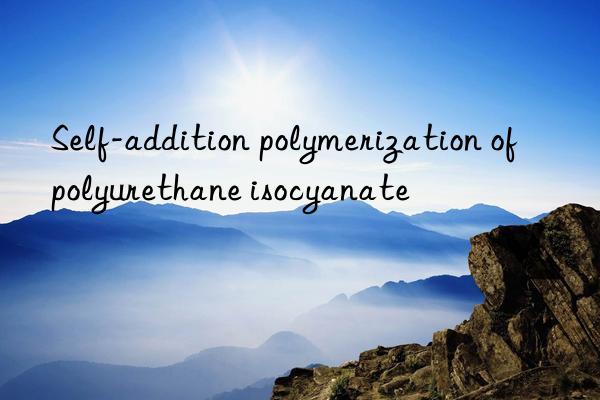
Isocyanates can undergo self-addition reactions to generate various Autopolymers include dimers, trimers and various multimers, the most important of which are dimerization and trimerization.
1. Dimerization of isocyanates
Generally speaking, only aromatic isocyanates can self-polymerize to form dimers, while aliphatic isocyanate dimers have not been reported. This is due to the high NCO reactivity of aromatic isocyanates. Aromatic isocyanates can slowly self-polymerize to form dimers even at low temperatures. The resulting dimer is a four-membered heterocyclic structure called diazetidinedione, also known as uretdione. The dimerization reaction of aromatic isocyanate is a reversible reaction and can be decomposed into the original isocyanate compound under heating conditions. Dimers can react directly with active hydrogen compounds such as alcohols or amines in the presence of a catalyst.
with ortho position Substituted aromatic isocyanates, such as 2,6-TDI, cannot form dimers at room temperature due to steric hindrance. Since 4,4'-MDI has no substituent at the ortho position of NCO, its activity is greater than that of TDI. Even in the absence of a catalyst, some monomers slowly self-polymerize into dimers at room temperature.
2,4-TDI dimer is a Special diisocyanate products reduce the volatility of TDI monomer. TDI dimer is a solid with a high melting point and is stable at room temperature. Its mixture with hydroxyl compounds is stable for storage at room temperature. It is mainly used as a vulcanizing agent for mixing polyurethane elastomers. It can also use the reversible characteristics of the dimerization reaction to prepare room-temperature stable high-temperature curing polyurethane elastomers and adhesives, such as the preparation of thermoplastic polyurethane containing dimer heterocycles. At the processing temperature of thermoplastic polyurethane, the NCO group is decomposed and participates in the reaction to generate cross-linked polyurethane.
Triane is available Phosphines, pyridines, and tertiary amines are used as catalysts for dimerization reactions. Commonly used phosphine compounds such as dimethylphenylphosphine can produce good catalytic effects in very small amounts. Pyridine can also be used, which also serves as a solvent to remove a large amount of reaction heat. HeatingTDI dimer to 150-175°C can decompose into TDI monomer even in the absence of a catalyst. In the presence of trialkylphosphine catalyst, when heated to 80°C, it can be 100% decomposed in benzene solution.
2, Three isocyanates Polyreaction
Aromatic or aliphatic (including alicyclic) isocyanates can self-polymerize into trimers under heating and catalysis. The core group of the trimer is isocyanuride. Acid ester (isocyanurate) six-membered heterocyclic ring.
Many nitrogen families Elemental compounds, organic metal compounds, etc. can be used as trimerization catalysts for aliphatic and aromatic isocyanates. N, N′, N″-tris(dimethylaminopropyl)-hexahydrotriazine and 2,4,6-tris(dimethylaminomethyl)phenol are commonly used tertiary amine trimerization catalysts .
In manufacturing When using isocyanurate-type polyisocyanate cross-linking agent, the degree of trimerization reaction needs to be controlled to avoid unlimited self-polymerization and useless substances with excessive polymerization. Generally, a small amount of polymerization inhibitor needs to be added to terminate the reaction. Inhibition of polymerization Agents include p-toluenesulfonate, benzoyl chloride, phosphoric acid, dimethyl sulfate, etc.
In the process of preparing polyurethane, the order of thermal stability of several chemical bonds and groups that can be generated is generally considered to be: isocyanuric acid Ester ringoxazolidinone ring>carbodiimide>urea>urethane>biuret>allophanate>uretdione ring. The isocyanurate ring is very stable and can Heat-resistant and flame-retardant. The thermal stability temperature of general isocyanurate is above 150°C, aromatic isocyanurate has higher heat resistance, and the thermal decomposition temperature of benzene isocyanurate ring is Above 380℃.
Like other isocyanate reactions, electronic effects and steric effects have a greater impact on the trimerization reaction of isocyanates. The electron-withdrawing groups on the benzene ring can accelerate the trimerization reaction, while the electron-donating groups slow down the trimerization reaction. ;�Intermediate effects also strongly affect the trimerization rate. The trimerization ability of aliphatic isocyanates is weaker than that of aromatic isocyanates.
The isocyanurate ring formed after isocyanate trimerization is relatively stable to heat and most chemicals, and is mainly used in the manufacture of rigid polyisocyanurate (PIR) foam. Add a trimerization catalyst to the polyether composition (premix). During foaming, excess polyisocyanate PAPI and some of the unreacted NCO groups on the PAPI that have reacted with polyether or polyester polyol will react at high temperatures. Trimerize to form PIR and polyurethane network polymers. PIR formed by trimerizing polyisocyanate monomers has many benzene rings, high cross-linking density, and is too brittle and has no practical value. Therefore, isocyanurate-modified polyurethane is generally used. The foam made in this way has a certain degree of toughness, high thermal deformation temperature, good dimensional stability, can be used for a long time at 150°C, and has good flame penetration resistance. Low combustion smoke. This kind of foam can be used in areas of thermal insulation that require heat resistance, such as heating pipe insulation.
Isocyanate The reaction to generate polyisocyanurate after trimerization is also used in the preparation of heat-resistant polyurethane adhesives, coatings and elastomers. Diisocyanate trimer cross-linking agent products such as 2,4-TDI trimer, HDI trimer, and IPDI trimer are actually mixtures of isocyanate autopolymers with various functionalities. Body is the main component. Mixed isocyanurates such as HDI-TDI mixed trimers can be produced from two or more isocyanate monomers under the catalysis of trialkyl tin alkoxide. They are mainly used as polyurethane Cross-linking agent for coatings, etc.

 微信扫一扫打赏
微信扫一扫打赏

